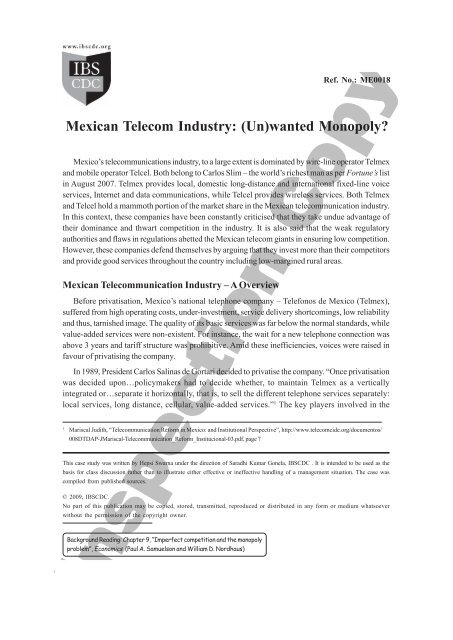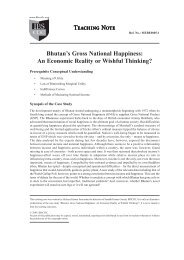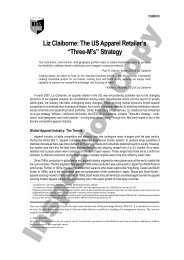Mexican Telecom Industry (Un)wanted Monopoly - Case Studies
Mexican Telecom Industry (Un)wanted Monopoly - Case Studies
Mexican Telecom Industry (Un)wanted Monopoly - Case Studies
Create successful ePaper yourself
Turn your PDF publications into a flip-book with our unique Google optimized e-Paper software.
1<br />
<strong>Mexican</strong> <strong>Telecom</strong> <strong>Industry</strong>: (<strong>Un</strong>)<strong>wanted</strong> <strong>Monopoly</strong>?<br />
<strong>Mexican</strong> <strong>Telecom</strong> <strong>Industry</strong>: (<strong>Un</strong>)<strong>wanted</strong> <strong>Monopoly</strong>?<br />
Mexico’s telecommunications industry, to a large extent is dominated by wire-line operator Telmex<br />
and mobile operator Telcel. Both belong to Carlos Slim – the world’s richest man as per Fortune’s list<br />
in August 2007. Telmex provides local, domestic long-distance and international fixed-line voice<br />
services, Internet and data communications, while Telcel provides wireless services. Both Telmex<br />
and Telcel hold a mammoth portion of the market share in the <strong>Mexican</strong> telecommunication industry.<br />
In this context, these companies have been constantly criticised that they take undue advantage of<br />
their dominance and thwart competition in the industry. It is also said that the weak regulatory<br />
authorities and flaws in regulations abetted the <strong>Mexican</strong> telecom giants in ensuring low competition.<br />
However, these companies defend themselves by arguing that they invest more than their competitors<br />
and provide good services throughout the country including low-margined rural areas.<br />
<strong>Mexican</strong> <strong>Telecom</strong>munication <strong>Industry</strong> – A Overview<br />
Before privatisation, Mexico’s national telephone company – Telefonos de Mexico (Telmex),<br />
suffered from high operating costs, under-investment, service delivery shortcomings, low reliability<br />
and thus, tarnished image. The quality of its basic services was far below the normal standards, while<br />
value-added services were non-existent. For instance, the wait for a new telephone connection was<br />
above 3 years and tariff structure was prohibitive. Amid these inefficiencies, voices were raised in<br />
favour of privatising the company.<br />
In 1989, President Carlos Salinas de Gortari decided to privatise the company. “Once privatisation<br />
was decided upon…policymakers had to decide whether, to maintain Telmex as a vertically<br />
integrated or…separate it horizontally, that is, to sell the different telephone services separately:<br />
local services, long distance, cellular, value-added services.” 1 The key players involved in the<br />
This case study was written by Hepsi Swarna under the direction of Saradhi Kumar Gonela, IBSCDC . It is intended to be used as the<br />
basis for class discussion rather than to illustrate either effective or ineffective handling of a management situation. The case was<br />
compiled from published sources.<br />
© 2009, IBSCDC.<br />
No part of this publication may be copied, stored, transmitted, reproduced or distributed in any form or medium whatsoever<br />
without the permission of the copyright owner.<br />
Ref. No.: ME0018<br />
1 Mariscal Judith, “<strong>Telecom</strong>munication Reform in Mexico: and Institutional Perspective”, http://www.telecomcide.org/documentos/<br />
008DTDAP-JMariscal-<strong>Telecom</strong>munication_Reform_Institucional-03.pdf, page 7<br />
Background Reading: Chapter 9, “Imperfect competition and the monopoly<br />
problem”, Economics (Paul A. Samuelson and William D. Nordhaus)<br />
Inspection Copy
2<br />
<strong>Mexican</strong> <strong>Telecom</strong> <strong>Industry</strong>: (<strong>Un</strong>)<strong>wanted</strong> <strong>Monopoly</strong>?<br />
policy reform were – National Investors, Telephone <strong>Un</strong>ion, Telmex, Foreign Investors, World<br />
Bank, Secretariat of Communications and Transport (SCT) and Secretaría de Comercio y Fomento<br />
Industrial (SECOFI) 2 . National investors, Telephone union, Telmex and SCT preferred vertically<br />
integrated firm, whereas foreign investors, World Bank and SECOFI favoured market<br />
segmentation. 3 Policymakers believed that market segmentation would enhance social welfare.<br />
However, because of time constraint for formulating and implementing the same, government<br />
decided to maintain Telmex as a vertically integrated firm. “An additional constraint, not openly<br />
acknowledged by policymakers, was given by the need to respond to preferences from newly<br />
established alliances that favoured an integrated firm.” 4<br />
In 1990, Grupo Carso <strong>Telecom</strong>, owned by Carlos Slim, acquired Telmex through a joint venture<br />
with Southwestern Bell and France <strong>Telecom</strong> for an exceptionally low price of $1.75 billion. Since<br />
foreign investment was limited to 49%, the two foreign companies teamed up with Grupo Carso<br />
<strong>Telecom</strong>. According to the agreement between the three, Grupo Carso possessed operating control<br />
of the company, Southwestern Bell was responsible for improving operations and developing paging<br />
and cellular divisions, and France <strong>Telecom</strong> concentrated on line expansion and modernisation.<br />
Although many foreign companies had offered higher amounts in the public auction, Grupo Carso<br />
<strong>Telecom</strong> won the bid. The fact that majority ownership would stay in Mexico, was a major<br />
determining factor than any specific business logic.<br />
After privatisation, Telmex was granted seven competition free years in both domestic and<br />
international telecommunications services on the condition that it invests at least $14 billion in upgrading<br />
the network and technology during that period. The company was given 5 years time to cut down<br />
waiting time for a new line to the maximum of 6 months. It was also asked to double the number of<br />
telephone lines in service. The decision to allow monopoly for Telmex, though temporarily, was<br />
based on three arguments. “First, foreign investors would require it (monopoly) in order to purchase<br />
Telmex for a substantial amount. Second, monopoly facilitated pursuit of a ‘universal service’<br />
objective – to serve households who could not afford service that was priced to recover its full<br />
cost, and to bring service to areas that were under-served because of difficult terrain, low population<br />
or generally low incomes. Third, monopoly was regarded as necessary to get private firms to<br />
commit to a major investment to improve service even to businesses and high-income households.<br />
Major investment would be required simply to eliminate the long waiting-list for service and the<br />
high rate of failure in completing or holding calls.” 5<br />
After privatisation, services improved tremendously. Earlier, people had to wait on the streets for<br />
a Telmex car to pass and bribe the technician for a line repair. Telmex also did better than expected in<br />
reducing the waiting time for a new line by bringing it down to 3 months. The number of wire-line<br />
(fixed line) and wireless telephones in service has grown significantly.<br />
2 Ministry of Trade and Industrial Development<br />
3 “<strong>Telecom</strong>munication Reform in Mexico: and Institutional Perspective”, op.cit., page 14<br />
4 Ibid., page 15<br />
5 Noll G. Roger, “Priorities for <strong>Telecom</strong>munications Reform in Mexico”, http://siteresources.worldbank.org/INTMEXICOINSPANISH/<br />
Resources/noll-paper.pdf, pages 5–6<br />
Inspection Copy
3<br />
<strong>Mexican</strong> <strong>Telecom</strong> <strong>Industry</strong>: (<strong>Un</strong>)<strong>wanted</strong> <strong>Monopoly</strong>?<br />
Although services improved, prices still remain high in Mexico. According to the Paris-based<br />
Organisation of Economic Cooperation & Development (OECD), Mexico remains one of the OECD<br />
countries with the highest telephone charges, especially for business use (Exhibit I). Eduardo Garcia,<br />
a business journalist in Mexico, observes, “If not for those rates, <strong>Mexican</strong> businesses would have<br />
generated better profits and could have paid their workers better. Mexico would have been a more<br />
efficient economy.” 6 These high rates, in turn, resulted in low overall wire-line and wireless penetration<br />
(Exhibits II (a) & (b)) and a low broadband penetration rate (Exhibit III). In 2006, in Mexico, it was<br />
reported that, “Only 18% have a phone line, phone calls costs 50% more than the OECD average,<br />
and only two in 100 have broadband, which puts the Latin American country second to last in the<br />
OECD rankings.” 7 Amidst all these spectacles and flaws, the <strong>Mexican</strong> telecom industry rests under<br />
the dominance of Telmex, even after expiry of monopoly period.<br />
Few competitors have managed to break through the market share of 90% held by Telmex (by<br />
2008). The necessary institutional and legal support to create a competitive market was absent during<br />
the reform process. Roger Noll (Noll) an economist at Stanford <strong>Un</strong>iversity, who advised <strong>Mexican</strong><br />
government on privatisation of Telmex believes, “the key error was not to set up an independent<br />
regulator in advance of the sale.” 8 Thus, a private monopoly replaced a public monopoly. In spite of<br />
Telmex’s monopoly in wire-line, the <strong>Mexican</strong> government allowed Slim to enter the wireless market too.<br />
In 2000,Telmex’s cellular operations in and outside Mexico were spun-off and the new company hence<br />
formed was named America Movil, which went on to become Latin America’s largest mobile phone<br />
operator. The <strong>Mexican</strong> arm of America Movil, named Telcel, enjoys a similar kind of dominance as, its<br />
fixed-line sister concern, Telmex does.<br />
6 Padgett Tim, “Carlos Slim’s Embarrassment of Riches”, http://www.time.com/time/business/article/0,8599,1642286,00.html, July 11 th<br />
2007<br />
7 Adams Greg, “Why <strong>Mexican</strong> phones cost a bundle”, http://www.nzherald.co.nz/topic/story.cfm?c_id=286&objectid=10377782, April<br />
18 th 2006<br />
8 Authers John and Silver Sara, “Slim’s pickings: Latin America’s richest man eyes up his next undervalued target MEXICO”, http://<br />
search.ft.com/ftArticle?queryText=carlos%20slim&page=4&y=9&aje=false&x=15&id=050425001205&ct=0, April 25 th 2005<br />
Inspection Copy
4<br />
1 Excluding VAT.<br />
2 Including VAT.<br />
<strong>Mexican</strong> <strong>Telecom</strong> <strong>Industry</strong>: (<strong>Un</strong>)<strong>wanted</strong> <strong>Monopoly</strong>?<br />
Exhibit I<br />
Telephone Charges in the OECD in $ (PPP* terms), August 2006<br />
2,500<br />
2,000<br />
1,500<br />
1,000<br />
500<br />
0<br />
-500<br />
1000<br />
500<br />
0<br />
-500<br />
1,400<br />
1,200<br />
1,000<br />
800<br />
600<br />
400<br />
200<br />
0<br />
NOR<br />
CHE<br />
DNK<br />
DNK<br />
CAN<br />
FIN<br />
DEU<br />
SWE<br />
SWE<br />
US<br />
DNK<br />
NLD<br />
*Purchasing Power Parity<br />
A. Charges for a composite business basket 1<br />
Fixed<br />
Usage<br />
12345<br />
12345<br />
12<br />
12<br />
Source: “Economic survey of Mexico 2007: Improving infrastructure in Mexico”, http://www.oecd.org/document/8/<br />
0,3343,en_2649_34569_39415560_1_1_1_1,00.html<br />
ISL<br />
NOR<br />
LUX<br />
ISL<br />
CAN<br />
US<br />
BEL<br />
LUX<br />
SWE<br />
DEU<br />
IRE<br />
IRE<br />
Discount<br />
Total charges<br />
CHE<br />
GBR<br />
NLD<br />
AUT<br />
12<br />
12<br />
12<br />
12<br />
12<br />
ESP<br />
ESP<br />
AUT<br />
JPN<br />
123<br />
123<br />
123<br />
123<br />
GRC<br />
B. Charges for a composite residential basket 2<br />
Fixed<br />
Usage<br />
12<br />
12<br />
12<br />
12<br />
12<br />
12<br />
NLD<br />
FIN<br />
KOR<br />
FRA<br />
NZL<br />
OECD<br />
BEL<br />
KOR<br />
FIN<br />
NZL<br />
FRA<br />
Inspection Copy<br />
JPN<br />
ITA<br />
ITA<br />
OECD<br />
HUN<br />
GBR<br />
PRT<br />
12<br />
12<br />
12<br />
12<br />
MEX<br />
AUS<br />
MEX<br />
GRC<br />
SVK<br />
AUS<br />
123<br />
123 12<br />
12 123<br />
123<br />
123<br />
123<br />
123<br />
123<br />
123<br />
PRT<br />
TUR<br />
TUR<br />
POL<br />
HUN<br />
123<br />
123<br />
SVK<br />
123<br />
CZE<br />
CZE<br />
POL<br />
2,500<br />
2,000<br />
1,500<br />
1,000<br />
500<br />
0<br />
-500<br />
12345<br />
12345 Discount<br />
1,000<br />
Total charges<br />
C. Mobile phone charges at different levels of consumption 2<br />
Low users<br />
Medium users<br />
High users<br />
NOR<br />
LUX<br />
GBR<br />
CHE<br />
CAN<br />
KOR<br />
IRE<br />
ISL<br />
FRA<br />
US<br />
AUT<br />
HUN<br />
OECD<br />
BEL<br />
NZL<br />
GRC<br />
DEU<br />
MEX<br />
ITA<br />
AUS<br />
POL<br />
JPN<br />
PRT<br />
SVK<br />
ESP<br />
CZE<br />
TUR<br />
500<br />
0<br />
-500<br />
1,400<br />
1,200<br />
1,000<br />
800<br />
600<br />
400<br />
200<br />
0
5<br />
<strong>Mexican</strong> <strong>Telecom</strong> <strong>Industry</strong>: (<strong>Un</strong>)<strong>wanted</strong> <strong>Monopoly</strong>?<br />
Exhibit II (a)<br />
Fixed-line Penetration Rate<br />
Comparative International Fixed Phone System-lines by Each 100<br />
Inhabitants 2006<br />
8.2<br />
Venezuela<br />
Malaysia<br />
Columbia<br />
Mexico<br />
Chile<br />
Brazil<br />
Argentina<br />
China<br />
Uruguay<br />
Finland<br />
Singapore<br />
Spain<br />
New Zealand<br />
Japan<br />
Italy<br />
Austria<br />
Norway<br />
Ireland<br />
Australia<br />
France<br />
Korea del sur<br />
UK<br />
Denmark<br />
US<br />
Sweden<br />
Canada<br />
Iceland<br />
Germany<br />
Peru<br />
15.5<br />
16.8<br />
17.0<br />
18.9<br />
20.2<br />
20.5<br />
24.2<br />
27.8<br />
28.3<br />
Source: http://www.cofetel.gob.mx/wb/Cofetel_2008/Cofe_comparativo_internacional_de_densidad_de_tel<br />
Exhibit II (b)<br />
Mobile Penetration Rate<br />
Comparative International Penetration of Mobile phone System-users by<br />
Each 100 Inhabitants 2006<br />
30.0<br />
34.8<br />
China<br />
Canada<br />
Brazil<br />
Mexico<br />
Columbia<br />
Uruguay<br />
Venezuela<br />
Malaysia<br />
Chile<br />
US<br />
Japan<br />
Argentina<br />
Korea del sur<br />
France<br />
New Zealand<br />
Australia<br />
Germany<br />
Sweden<br />
Spain<br />
Denmark<br />
Finland<br />
Norway<br />
Singapore<br />
Iceland<br />
Ireland<br />
Austria<br />
UK<br />
Italy<br />
Peru<br />
52.5<br />
52.9<br />
54.1<br />
36.5<br />
42.3<br />
42.4<br />
64.3<br />
66.8<br />
69.0<br />
75.5<br />
75.6<br />
77.4<br />
79.3<br />
80.5<br />
83.8<br />
85.1<br />
87.6<br />
97.0<br />
101.9<br />
105.9<br />
106.4<br />
107.3<br />
107.8<br />
108.6<br />
109.3<br />
110.6<br />
Source: http://www.cofetel.gob.mx/wb/Cofetel_2008/Cofe_comparativo_internacional_de_penetracio_n_de<br />
42.9<br />
43.0<br />
43.1<br />
43.4<br />
44.3<br />
48.8<br />
Inspection Copy<br />
48.8<br />
55.8<br />
56.0<br />
56.2<br />
56.9<br />
57.2<br />
61.2<br />
64.1<br />
65.2<br />
65.5<br />
111.4<br />
112.8<br />
116.4<br />
123.1
6<br />
<strong>Mexican</strong> <strong>Telecom</strong> <strong>Industry</strong>: (<strong>Un</strong>)<strong>wanted</strong> <strong>Monopoly</strong>?<br />
Exhibit III<br />
Broadband Penetration Rate<br />
OECD Broadband Subscribers per 100 Inhabitants, by Technology, December 2006<br />
DSL Cable Fibre/LAN Other Total Total Subscribers<br />
Denmark 19.6 9.4 2.6 0.4 31.9 1,728,359<br />
Netherlands 19.5 12.0 0.4 0.0 31.8 5,192,200<br />
Iceland 28.8 0.0 0.2 0.6 29.7 87,738<br />
Korea 11.4 10.7 7.0 0.0 29.1 14,042,728<br />
Switzerland 18.8 8.8 0.0 0.9 28.5 2,140,309<br />
Norway 21.7 3.8 1.5 0.6 27.7 1,278,346<br />
Finland 23.5 3.5 0.0 0.3 27.2 1,428,000<br />
Sweden 16.0 5.2 0.0 4.8 26.0 2,346,300<br />
Canada 11.4 12.3 0.0 0.1 23.8 7,675,533<br />
Belgium 14.0 8.4 0.0 0.1 22.5 2,353,956<br />
UK 16.5 5.1 0.0 0.0 21.6 12,993,354<br />
Luxembourg 18.2 2.2 0.0 0.0 20.4 93,214<br />
France 19.1 1.1 0.0 0.0 20.3 12,699,000<br />
Japan 11.1 2.8 6.2 0.0 20.2 25,755,080<br />
US 8.5 10.3 0.3 0.6 19.6 58,136,577<br />
Australia 15.0 3.3 0.0 1.0 19.2 3,939,288<br />
Austria 10.6 6.4 0.0 0.3 17.3 1,427,986<br />
Germany 16.4 0.5 0.0 0.1 17.1 14,085,232<br />
Spain 12.1 3.1 0.0 0.1 15.3 6,654,881<br />
Italy 13.8 0.0 0.4 0.6 14.8 8,638,873<br />
New Zealand 12.7 0.6 0.0 0.7 14.0 576,067<br />
Portugal 8.7 5.1 0.0 0.0 13.8 1,460,341<br />
Ireland 9.1 1.3 0.0 2.0 12.5 517,300<br />
Hungary 6.1 3.8 0.0 2.0 11.9 1,198,709<br />
Czech Republic 4.8 2.1 0.0 3.7 10.6 1,086,620<br />
Poland 5.2 1.6 0.0 0.1 6.9 2,640,000<br />
Slovak Republic 3.4 0.7 0.9 0.2 5.1 274,108<br />
Greece 4.4 0.0 0.0 0.2 4.6 512,000<br />
Turkey 3.8 0.0 0.0 0.0 3.8 2,773,685<br />
Mexico 2.7 0.8 0.0 0.0 3.5 3,728,150<br />
OECD 10.5 4.9 1.1 0.3 16.9 197,463,934<br />
Source: http://www.oecd.org/dataoecd/37/39/38449070.xls<br />
Inspection Copy
<strong>Monopoly</strong> of Telmex and Telcel<br />
7<br />
<strong>Mexican</strong> <strong>Telecom</strong> <strong>Industry</strong>: (<strong>Un</strong>)<strong>wanted</strong> <strong>Monopoly</strong>?<br />
While Telmex got natural monopoly through privatisation, Slim implemented ‘Gillette Plan’ 9 to<br />
establish Telcel’s dominance in the mobile market. Following this strategy, mobile phones were<br />
sold at cheaper prices, as once the customer bought a mobile phone they needed prepaid phone<br />
cards to use it constantly. The strategy worked well and the company made huge profits. According<br />
to a report in 2008, “America Movil, the largest cell phone operator in Latin America, provides<br />
service to 7 out of every 10 mobile users in Mexico, well ahead of the No. 2 operator, Movistar,<br />
the brand of Spain’s Telefonica.” 10<br />
Telmex’s direct competitors include fixed line companies such as Axtel, Alestra, Maxcom<br />
<strong>Telecom</strong>unicaciones and cable TV companies like Megacable Holdings. In 2006, Mexico had around<br />
20 million fixed lines in service, out of which Telmex had 18.3 million fixed lines in service. The<br />
number of fixed line subscribers is going down in Mexico as customers are switching to wireless<br />
services. In the first quarter of 2008, Telmex had 17.8 million fixed lines in service with 90% of the<br />
market share while all the other operators having decimal share.<br />
Telcel operates on GSM technology, while the other operators Telfonica’s Movistar is based on<br />
GSM and Grupo Lusacell (merged with <strong>Un</strong>efon) is into CDMA technology. Digital trunking operator<br />
Nextel de México is emerging as a strong competitor for post-paid business customers. For the first<br />
quarter of 2008, Mexico had 71 million mobile subscribers out of its population of 109 million people.<br />
Telcel, Movistar, Lusacell and Nextel had 51.4 million, 13.3 million, (just under) 4 million and 2.3<br />
million subscribers, translating to a market share of 72.5%, 18.7%, 5.6% and 3.2% respectively.<br />
Having established their monopoly, both Telmex and Telcel have been charging high prices for all<br />
its services including Internet services. However, excessive charges are denied to such an extent that<br />
once, Slim even raised questions on the credibility of OECD. In an interview with BusinessWeek in<br />
2007, “he called the OECD charges false and denied he’s a monopolist.” 11 Even, the Comision<br />
Federal de <strong>Telecom</strong>unicaciones (Cofetel) 12 denies the accusations of over pricing. It states that<br />
Telmex’s charges have risen by less than inflation since 1998 and the prices were frozen since 2001.<br />
Further, it claims that local call prices are at or below international averages and it has forced Telmex<br />
to expand the network. But according to Professor Noll, the international comparisons are unrealistic,<br />
since many foreign companies offer packages including free long-distance calls or unlimited local<br />
calls. 13 He opines, “Prices were bound to fall because of the nature of technology in the sector. If<br />
there have been improvements, it’s because reductions in costs have caused the profit-maximising<br />
monopoly price to fall. It’s still the profit-maximising monopoly price.” 14<br />
9 Slim’s Gillette plan is modelled on the Gillette’s practice of selling shavers for a low price and then making profits on the replacement<br />
razor blades.<br />
10 Aspin Chris, “Mexico widens power probe of Slim’s America Movil”, http://www.reuters.com/article/marketsNews/<br />
idINN3022791220080430?rpc=44& pageNumber=1&virtualBrandChannel=0, April 30 th 2008<br />
11 Smith Geri, “Carlos Slim’s Fat Fortune”, http://www.businessweek.com/globalbiz/content/jul2007/gb2007073_887601.htm, July 4 th 2007<br />
12 Federal <strong>Telecom</strong>munications Commission<br />
13 “Slims pickings: Latin Americas richest man eyes up his next undervalued target MEXICO”, op.cit.<br />
14 Ibid.<br />
Inspection Copy
8<br />
<strong>Mexican</strong> <strong>Telecom</strong> <strong>Industry</strong>: (<strong>Un</strong>)<strong>wanted</strong> <strong>Monopoly</strong>?<br />
Added to imposing higher prices on customers, Telmex is also accused of charging competitors<br />
high interconnection fees. In Mexico, the charges are said to be high above the average cost incurred<br />
for interconnection service. For instance, in 2000, Avantel’s15 60% of the revenue directly went to<br />
Telmex in the form of interconnectivity fees. By all accounts, the revenues of Telmex and Telcel can<br />
be attributed to the fact that they have abused their dominant position, by over-charging customers<br />
and competitors. Regulatory frame work and anti-competitive authorities are blamed for letting both<br />
the companies’ scot free.<br />
Regulation in Mexico<br />
Article 13 of the Federal Law of Economic Competition of Mexico defines a company as monopoly,<br />
by examining whether it can unilaterally set the prices or restrict the supply in the relevant market<br />
without the competitive agents being able to act or to potentially counteract that power.<br />
In 1993, to ban anti-competitive behaviour by companies, Mexico adopted Federal Law of Economic<br />
Competition (LFCE). The competition policy goals of LFCE are: “to protect the competitive process<br />
and free market access by preventing monopolies, monopolistic practices and other restraints of the<br />
efficient functioning of markets for goods and services.” 16 Comisión Federal de Competencia (CFC) 17<br />
was created to enforce LFCE. CFC is responsible for investigating abusive monopoly practices of<br />
companies. It also determines the companies, which have dominant position in any sector.<br />
LFCE classifies monopolistic practices as absolute and relative. Absolute monopolistic practices<br />
are prohibited. This include four types of horizontal agreements18 between competitors such as price<br />
fixing, output restriction, market division and bid rigging. Whereas, relative monopolistic practices are<br />
not termed illegal unless a company is found to have substantial power in the respective market.<br />
Vertical agreements19 like vertical market division, resale price maintenance, tied sales, exclusive<br />
dealing and refusal to deal are considered to be relative monopolistic practices. Other horizontal<br />
practices are also termed as relative practices – collectively treated as a catch-all provision – that will<br />
unduly damage or impair the process of competition and free access to production, processing,<br />
distribution and marketing of goods and services. 20<br />
In conjunction with the above, the competition laws around the world also prohibit two types of<br />
monopolistic behaviours under abuse of dominance provisions. They are exploitative conduct and<br />
exclusionary conduct. 21 However, <strong>Mexican</strong> competition law does not prosecute exploitative practices<br />
15 Avantel, a long-distant company, competitor of Telmex, entered the <strong>Mexican</strong> long-distance market in 1995.<br />
16 “Competition Law and Policy in Mexico: An OECD PEER REVIEW”, http://www.oecd.org/dataoecd/57/9/31430869.pdf, page 11<br />
17 Federal Competition Commission<br />
18 An agreement between competing firms in the same industry, which may result in reduced competition.<br />
19 An agreement between two or more companies operating at different levels of production, distribution or supply chain. These arrangements<br />
can, but not limited to, substantially prevent or lessen competition and thus can potentially violate antitrust laws.<br />
20 “Competition Law and Policy in Mexico: An OECD PEER REVIEW”, op.cit., page 19<br />
21 A dominant firm when it uses its monopoly power to exploit the customers or the suppliers, it is known as exploitative conduct. Charging<br />
monopoly prices to customers and paying low prices to suppliers are examples of exploitative conduct. A conduct which aims at<br />
excluding competition to maintain market power is termed as exclusionary conduct. Refusal to deal, filing lawsuits in order to suppress<br />
competitors and increasing rival costs are some of the examples of exclusionary abuse.<br />
Inspection Copy
9<br />
<strong>Mexican</strong> <strong>Telecom</strong> <strong>Industry</strong>: (<strong>Un</strong>)<strong>wanted</strong> <strong>Monopoly</strong>?<br />
such as charging monopolistic prices, but encourages actions against exclusionary abuses. “<strong>Un</strong>lawful<br />
conduct is defined solely in terms of exclusionary practices at the expense of competitors or other<br />
firms in the chain of distribution, and not in terms of exploitative practices at the expense of<br />
consumers.” 22 There is no provision for fair competition under this law, neither does it talk about<br />
protecting the interest of small enterprises and restricting business concentration. Even though both<br />
<strong>Mexican</strong> constitution and LFCE ban monopoly, no section of law deals with monopoly as such or<br />
with abuse of dominance.<br />
Competition and Regulation in Context of <strong>Mexican</strong> <strong>Telecom</strong> <strong>Industry</strong><br />
“You don’t tug on Superman’s cape, you don’t spit into the wind, you don’t pull the mask of that old Lone<br />
Ranger and you don’t mess around Slim.” 23<br />
– Jim Croce<br />
<strong>Un</strong>til 1995, in Mexico the national telephone industry was regulated by SCT. In 1996, a Presidential<br />
decree created Cofetel as an autonomous entity from SCT to regulate and develop the <strong>Mexican</strong><br />
<strong>Telecom</strong> <strong>Industry</strong>. Cofetel is responsible for implementing regulations and technical standards. It is<br />
also responsible for resolving the conflicts between competitors regarding interconnection fees. Cofetel<br />
has operational and technical autonomy but lacks political autonomy. It limits to suggesting on major<br />
issues to SCT and SCT retains the power to grant all concessions – it is the final deciding authority.<br />
Once a decision is made, Cofetel implements it.<br />
Telmex is regulated through price cap. 24 The price cap consists of a basket of five services –<br />
installation charges; monthly rental fee; local measured services; national or domestic long-distance<br />
and international long-distance. Leased lines25 are not under the price cap, Telmex is not regulated<br />
in that aspect. From time to time, the value of basket is re-estimated by the government and it<br />
requires Telmex to pass the benefits of productivity and efficiency to the customers to reduce the<br />
real value of basket by a definite percentage. The reduction is equal to 4.5% per year. Annual price<br />
increase is calculated by deducting 4.5% from the rate of inflation for the respective year. Owing to<br />
technological improvements and augmented efficiency, “Telmex has experienced productivity gains<br />
in excess of the 4.5% target, allowing it to earn increasing profits while not raising prices as fast as<br />
is allowed under the price-cap formula.” 26 Telmex sends a letter to the Cofetel with the rates, then<br />
Cofetel decides whether the rates have to be registered or not. Once the rates are registered, it’s a sort<br />
of consent that the rates are applicable.<br />
Competition entered the <strong>Mexican</strong> long-distance market in 1997 and later in other segments of<br />
telecommunications like local service and mobile market. Since foreign investment was limited to<br />
22 “Competition Law and Policy in Mexico: An OECD PEER REVIEW”, op.cit., page 25<br />
23 Friday Bill, “Once Upon a Time in Norte America: The Rise of Carlos Slim”, http://www.losangeles.broowaha.com/article.php?id=962,<br />
March 14 th 2007<br />
24 Price cap is the maximum value for a price index of basic residential and business services.<br />
25 A leased line is a symmetric telecommunications line connecting two locations. It does not have a telephone number and each side of<br />
the line is permanently connected to the other. Leased lines can be used for telephone, data or Internet services.<br />
26 “Priorities for <strong>Telecom</strong>munications Reform in Mexico”, op.cit., page 17<br />
Inspection Copy
10<br />
<strong>Mexican</strong> <strong>Telecom</strong> <strong>Industry</strong>: (<strong>Un</strong>)<strong>wanted</strong> <strong>Monopoly</strong>?<br />
49%, AT&T entered the long-distance market as a joint venture with Alestra. Worldcom followed<br />
suit by joining with Avantel, but Telmex retorted with patriotic marketing and advertising. In 1998,<br />
Avantel intended to introduce long-distance calls from public phones using prepaid cards. As majority<br />
of the public phones were operated by Telmex, Avantel was denied a free number by Telmex – a<br />
prerequisite for long-distance calls – and the initiative faced major obstacle. Avantel also faced high<br />
interconnection fees. When it took Telmex to court for monopolistic practices – Telmex kept it at bay<br />
by getting a judge to issue an arrest warrant for the top lawyer of Avantel. “Avantel eventually<br />
defaulted on its debt in 2001, much of which were scooped by Mr. Slim and later sold for a profit.” 27<br />
Frank Voytek, AT&T’s representative on Alestra’s board says, “Our expectation when we made our<br />
investment was that the regulator would enforce the regulations”. 28<br />
“Part of Cofetel’s problem in implementing effective regulation arises from its inability to convince<br />
the courts that its regulations are reasonable and necessary. An important aspect of judicial review in<br />
Mexico is the amparo.” 29 An amparo30 can result in obtaining a stay order in the implementation of a<br />
court decree for years. Even if the party, which filed the amparo, loses the lawsuit, much time elapses<br />
by then. In 1997, for example, CFC determined that Telmex had substantial power in five telephony<br />
markets namely, local telephony service; national long-distance service; international long-distance<br />
service; access or interconnection to local networks; and interurban transport. In August 1998, Telmex<br />
filed an amparo. Telmex successfully challenged before court the authority of CFC to declare it<br />
dominant in five telecommunications markets. Time and again Telmex filed many amparos challenging<br />
the decisions of CFC and Cofetel, and this amparo abuse has costed <strong>Mexican</strong> economy dearly.<br />
Karina Duyich, former head of AT&T Mexico’s legal department remarks, “Since 1998, Slim has<br />
made use of more than 60 amparos to thwart decisions by Mexico’s antitrust agency, the Comisión<br />
Federal de Competencia, ordering Telmex to reduce its interconnection rates – the fees rivals must<br />
pay to use Telmex trunk lines. Telmex’s very aggressive use of the amparo has ended any hope of an<br />
open telecommunications market in Mexico.” 31<br />
In 2000, CFC once again came down on Telmex for its refusal to deal with the competitors.<br />
For instance a customer who called a toll free number (an 800 number) operated by other longdistant<br />
operator using Telmex public phone, had to buy its prepaid cards. But the toll free numbers<br />
operated by Telmex were accessible without any charges. Telmex refused to deal with the<br />
competitors regarding the issue. Because of this, a case was filed against Telmex and it was<br />
27 Luhnow David, “The Secrets of World’s Richest Man” , http://online.wsj.com/article/SB118615255900587380.html?mod=US-Business-<br />
News, August 4 th 2007<br />
28 Preston Julia, “INTERNATIONAL BUSINESS; Competitors of Telmex Say It Still Acts Like a <strong>Monopoly</strong>”, http://query.nytimes.com/gst/<br />
fullpage.html?res=9802E1DB163FF937A35757C0A9669C8B63&sec=&spon=&page<strong>wanted</strong>=2, April 4 th 2000<br />
29 “Priorities for <strong>Telecom</strong>munications Reform in Mexico”, op.cit., page 20<br />
30 An Amparo is a proceeding established in Articles 103 and 107 of the <strong>Mexican</strong> Constitution to provide citizens with protection against<br />
unconstitutional acts of the government. An action for amparo can be filed whenever a fundamental human right provided under<br />
Federal Constitution is allegedly infringed by any government agency. Parties can attack the government agency decisions in an<br />
amparo because the due process clause in the article 16 of the <strong>Mexican</strong> Constitution requires that agency orders articulate the ‘legal<br />
basis and justification for the actions taken’.<br />
31 Roberts M. James and Ortega Israel, “How Reforms in Mexico Could Make the U.S More Secure”, http://www.heritage.org/Research/<br />
LatinAmerica/bg2135.cfm, May 13 th 2008<br />
Inspection Copy
11<br />
<strong>Mexican</strong> <strong>Telecom</strong> <strong>Industry</strong>: (<strong>Un</strong>)<strong>wanted</strong> <strong>Monopoly</strong>?<br />
ordered to enter into an agreement with its competitors. As a result Telmex provided a free toll<br />
free number to competitors who concluded an agreement with it. But by then competitors had lost<br />
considerable amount of business.<br />
In the same year, Cofetel ordered a 63% reduction in interconnection fees, which Telmex charged<br />
its competitors for international calls. However, Telmex took advantage of Cofetel’s weakness and<br />
delayed in complying with the order by filing injunctions in various courts. In the meantime, there was<br />
a significant progress in the reduction of <strong>Mexican</strong> domestic interconnection fees, but international<br />
long-distance interconnection fee remained mostly unchanged. Mexico failed to address concerns of<br />
US telecom companies in regard to the high interconnection fees, which Telmex charged US carriers.<br />
In 2002, US requested a WTO panel to take up the matter. In 2004, US won the WTO<br />
telecommunications case against Mexico – in particular against Telmex. It was estimated that Mexico’s<br />
artificially high interconnection charges resulted in excess payments by US companies and consumers<br />
well over $1 billion since 2000. 32<br />
It has not been easy to compete in <strong>Mexican</strong> mobile market too. OECD referring to Telcel in its<br />
report (Economic survey of Mexico 2007: Improving infrastructure in Mexico) declared, “In the<br />
mobile telephone market, in particular, the dominant firm is using its market power to squeeze out<br />
other players”. 33 But Slim has always maintained that he likes competition, and commented that, “We<br />
have never opposed the entry of a competitor, let them come on in.” 34 In 2004, Movistar, the second<br />
largest mobile operator in Mexico, to increase market share, started selling mobile handsets at a<br />
cheaper price. But many of its sold phones were never used. Movistar discovered that Telcel purchased<br />
its handsets, replaced the chip and resold them. Movistar filed a case against Telcel. In 2006, CFC<br />
announced Telcel guilty of monopolistic practices as it refused to allow SMS exchange with Nextel. In<br />
November 2007, Movistar filed many complaints against Telcel and Telmex with CFC. It appealed<br />
CFC to compel both the companies to connect its competitors to their network on fair terms. In 2007,<br />
government started an investigation into dominance and monopolistic practices of Telmex in broadband<br />
Internet. In 2008, as many as eight probes were initiated against Telmex and Telcel, of which six are<br />
investigating Telmex’s dominance related issues, while one is into interconnection fee of Telcel and<br />
another to determine whether Telcel wields substantial power in <strong>Mexican</strong> mobile market. Eduardo<br />
Perez Motta, president of CFC said that these investigations would be concluded by mid-2008. All<br />
eyes are set on the results of the ongoing investigations, competitors are hoping that after investigations<br />
are through, both Telmex and Telcel will be made to reduce the interconnection fees.<br />
CFC’s and Cofetel’s major constraint are their limited powers and the amparos filed against their<br />
rulings. These amparos delay regulatory rulings against the companies. Also, time and again, Telmex<br />
and Telcel have used skilful lobbying and legal battles to defend themselves against regulation and<br />
antitrust prosecution. Telmex has repeatedly delayed signing interconnection agreement with<br />
32 “US wins WTO <strong>Telecom</strong>munications <strong>Case</strong> Against Mexico”, http://www.america.gov/st/washfile-english/2004/March/<br />
20040312162758ASrelliM7.784671e-02.html, March 12 th 2004<br />
33 “Economic survey of Mexico 2007:Improving infrastructure in Mexico”, http://www.oecd.org/document/8/<br />
0,3343,en_2649_34569_39415560_1_1_1_1,00.html , October 4 th 2007<br />
34 Malkin Elisabeth, “New Commitment to Charity by <strong>Mexican</strong> Phone Tycoon”, http://www.nytimes.com/2007/06/28/business/worldbusiness/<br />
28slim.html?_r=1&scp= 5&sq=&st=nyt&oref=slogin, June 28 th 2007<br />
Inspection Copy
12<br />
<strong>Mexican</strong> <strong>Telecom</strong> <strong>Industry</strong>: (<strong>Un</strong>)<strong>wanted</strong> <strong>Monopoly</strong>?<br />
competitors. Due to its dominant position, it does not respect the interconnection fee fixed by Cofetel<br />
and continues to charge high tariff per minute. Mexico’s constitution has always banned monopolies,<br />
but it is a country where corruption is widely spread. Nearly 62% of the companies have admitted to<br />
the fact that they reserve money to bribe government officials. 35 Slim is alleged to have friends in high<br />
places. Actions to curtail Telmex’s monopoly power during Carlos Salinas, Ernesto Zedillo and Vicente<br />
Fox administrations have not yielded desired results. There were rumours that President Carlos<br />
Salinas, who sold Telmex to Slim, secretly benefited from the sale. Critics believe Slim alone has not<br />
crushed competition; he had help from <strong>Mexican</strong> Presidents Ernesto Zedillo and Vincent Fox. In 2000,<br />
President Vincent Fox appointed Pedro Cerisola, a former employee of Telmex as Secretary to SCT.<br />
During his tenure (till 2006), he was alleged for protecting Telmex’s interests. Denise Dresser, a<br />
political analyst and professor at the Instituto Tecnológico Autónomo de México says, “Mexico has a<br />
dense, intricate web of connections and personal ties between the government and the business class,<br />
this ends up creating a government that doesn’t defend the public interest, that isn’t willing to go out<br />
and regulate in the name of the consumer, it is rather willing to help its friends, its allies and, in some<br />
cases, its business partners thrive at the expense of the <strong>Mexican</strong> people”. 36<br />
Slim’s political connections combined with the weak regulatory system of Mexico enabled him to<br />
defend his companies against the accusations of monopolistic business practices. It is widely published<br />
that Telmex’s and Telcel’s market dominance can be attributed to hands off policy of <strong>Mexican</strong><br />
legislature and no British or US government would have allowed this. Perez Motta says, “Mexico’s<br />
telecommunications regulatory framework and regulator remain weak and have failed, to some extent,<br />
to foster access and competition, Telmex has challenged CFC and (Comision Federal de<br />
<strong>Telecom</strong>unicaciones, or Cofetel) decisions before the courts and has been successful in delaying<br />
enforcement. All these circumstances have allowed it to maintain and exercise its market power<br />
through relative monopolistic practices.” 37 Cofetel has been criticised for lacking teeth to enforce<br />
effective regulation. Researchers at Syracuse <strong>Un</strong>iversity note, “Since its creation, Cofetel has assumed<br />
what can only be described as a pro-Telmex role in implementing its regulatory duties. As a result, the<br />
incumbent enjoys a monopoly over local, long distance, cellular and Internet services in Mexico. Its<br />
highly dominant position is largely because regulators have failed miserably.” 38 Whatever the reason<br />
may be, the <strong>Mexican</strong> economy and <strong>Mexican</strong> people are facing the consequences.<br />
35 Varsavsky Martin, “Carlos Slim is the richest man in the world: Should <strong>Mexican</strong>s be proud?”, http://english.martinvarsavsky.net/<br />
general/carlos-slim-is-the-richest-man-in-the-world-should-mexicans-be-proud.html, July 21 st 2007<br />
36 Coster Helen, “Slim’s Chance”, http://members.forbes.com/forbes/2007/0326/134.html, March 26 th 2007<br />
37 “Why <strong>Mexican</strong> phones cost a bundle”, op.cit.<br />
38 Ibid.<br />
Inspection Copy
Effects of <strong>Monopoly</strong> of Telmex and Telcel<br />
13<br />
<strong>Mexican</strong> <strong>Telecom</strong> <strong>Industry</strong>: (<strong>Un</strong>)<strong>wanted</strong> <strong>Monopoly</strong>?<br />
“The great evil in economics is not communism, not socialism, not capitalism, not landlords or bosses, not<br />
unions, not feudalism or industrialization or automation, not progress or lack of it, and not any scarcity of<br />
natural resources. No, the great evil in economics is COERCIVE MONOPOLY.” 39<br />
– Fred E. Foldvary<br />
In the bid to sell Telmex, <strong>Mexican</strong> government hiked telephone tariffs. In 1990, it eliminated<br />
indirect taxes on telephone services and allowed Telmex to absorb the remaining taxes into the prices.<br />
As a result local calls, which accounted for major part of the revenue for telecom companies, increased<br />
from 16 pesos per minute to 115 pesos. 40 According to a 1992 World Bank report on Telmex sale, the<br />
biggest losers from the privatisation of Telmex were the consumers, who had to bare the additional<br />
burden of 92 trillion <strong>Mexican</strong> pesos in the form of higher charges. The government, domestic<br />
shareholders and employees gained 16, 43 and 23.5 trillion pesos respectively. The best gain was<br />
bagged by the foreign investors who captured 90% of the net benefits from the sale, translated into 67<br />
trillion pesos. “The privatisation of Telmex, along with its attendant price-tax regulatory regime, has<br />
the result of `taxing’ consumers – a rather diffuse, unorganised group – and then distributing the gains<br />
among more well-defined groups, (foreign) shareholders, employees and the government.” 41 However,<br />
the report projected that the consumers would benefit in the long run by reduced prices.<br />
The projection proved to be a rather far fetched imagination. The <strong>Mexican</strong> customers are saddled<br />
under high telephone charges since then. Owing to high charges, the usage rate (minutes of use per<br />
subscriber per month) is very less in Mexico, thus resulting in deadweight loss42 . Professor Noll<br />
opines, “there is enormous loss of efficiency arising from the dominance of Telmex, especially with<br />
respect to the underutilisation of the network (low minutes of use) and the low penetration of the<br />
Internet.” 43 He also says, “Mexico has low wire-line penetration, but many developing countries have<br />
low wire-line penetration. The big problem is that Mexico does not offset this with high wireless<br />
penetration. Moreover, wireless penetration is less than it seems because many intensive business<br />
users carry cell phones for multiple carriers in order to take advantage of the much lower withinsystem<br />
calling charges compared to the extremely high prices for inter-system calling.” 44<br />
Economists opine that high costs of telephone and Internet services that resulted from lack of<br />
competition are hindering <strong>Mexican</strong> economy’s growth. In Mexico “high telephone and electricity<br />
costs, blamed on monopolies, are driving many factories to countries like China.” 45 Felipe Calderón,<br />
who became the President of Mexico in December 2006, vowed to make Mexico more competitive<br />
by dismantling monopolies. In November 2007, he affirmed once more, that increasing competition<br />
in telecommunication industry was his priority. But, till mid 2008, there were not any significant move<br />
against big companies. Some say that the telecom investigations which are ongoing will be a big test of<br />
whether President Calderón and CFC are up to the task.<br />
39 Foldvary E. Fred, “Natural monopolies”, http://www.progress.org/fold74.htm<br />
40 Hansen Karen, “Privatization Of Mexico: Telmex”, http://www.50years.org/factsheets/telmex.html, April 1997<br />
41 Hansen Karen, “Privatization Of Mexico: Telmex”, http://www.50years.org/factsheets/telmex.html, April 1997<br />
42 Deadweight loss refers to deficiency in resource utilisation due to inefficient allocation. It could also be defined as loss in total welfare<br />
due to a monopoly market. A monopolist’s high prices and low output create deadweight loss.<br />
43 Excerpt from an exclusive interview of Prof. Roger Noll conducted by the author. Please refer Annexure I for the full interview.<br />
44 Ibid.<br />
45 Bremer Catherine, “Stick to goals on monopolies, US tells Mexico”, http://www.reuters.com/article/companyNewsAndPR/<br />
idUSN0127660320070202?sp=true, February 1 st 2007<br />
Inspection Copy
14<br />
<strong>Mexican</strong> <strong>Telecom</strong> <strong>Industry</strong>: (<strong>Un</strong>)<strong>wanted</strong> <strong>Monopoly</strong>?<br />
Annexure I<br />
Interview with Prof. Roger Noll<br />
Roger Noll is a professor of Economics <strong>Un</strong>iversity of Stanford. He has a<br />
Ph.D. from Harvard and B.S. California Institute of Technology. Prof.<br />
Noll’s research interests include public policies towards business,<br />
rational actor models of public policy making, political behaviour and<br />
legal processes. He had been a consultant to the Government of Mexico<br />
during privatisation of its telecom sector.<br />
1) It is reported in some quarters that Mr.Slim abuses his monopoly by over charging<br />
customers and the peers with higher interconnectivity fees. How do you read, rather what do<br />
you read into, such reports? Also is he correct in denying high charges saying he provides good<br />
services?<br />
I think it is not appropriate to attribute the pricing of Telmex solely to Mr. Slim. Telmex is a publicly<br />
traded corporation, and all of its owners and executives are responsible for its performance. In<br />
addition, Telmex is regulated by Cofetel, which bears some responsibility for its prices. Telmex is<br />
among the world’s most profitable telephone companies. These profits arise from high prices across<br />
the board, including interconnectioncharges that are above the marginal and average cost of<br />
interconnection service. The quality of service is irrelevant to whether prices exceed average and<br />
marginal cost and profits substantially exceed the competitive return on investment. In addition, using<br />
the standard measures of service quality that are used by the International <strong>Telecom</strong>munications<br />
<strong>Un</strong>ion to assess the performance of telecommunications carriers throughout the world, Telmex is not<br />
a leader among carriers in peer nations (that is, nations with roughly Mexico’s per capita income,<br />
distribution of income, and geographic and demographic characteristics).<br />
2) Is it therefore right to say that Mr.Slim is thwarting competition or is he playing fair?<br />
Telmex certainly has not provided any assistance to its competitors, but to expect otherwise is<br />
misguided. The history of incumbent monopoly telephone companies in all nations after competition<br />
was made legal is similar. Incumbents always try to protect their monopoly. The difference between<br />
Mexico and other countries where the performance of the telecommunications industry is superior is<br />
that public policy in Mexico has not succeeded in promoting competition, partly because Cofetel is a<br />
very weak regulatory agency and partly because Mexico has not reformed its administrative<br />
procedures, including the standards and process for judicial review of decisions by Cofetel and the<br />
Competition Commission. Thus, the fault for the failure of the <strong>Mexican</strong> telecommunications industry<br />
to be reasonably competitive and to provide services at reasonable prices to its citizens rests with the<br />
government.<br />
3) It is argued that privatisation of <strong>Mexican</strong> <strong>Telecom</strong> industry replaced a public monopoly with<br />
a private monopoly. Do you confer with this argument? or is there any economic logic against<br />
this argument?<br />
Contd...<br />
Inspection Copy
15<br />
<strong>Mexican</strong> <strong>Telecom</strong> <strong>Industry</strong>: (<strong>Un</strong>)<strong>wanted</strong> <strong>Monopoly</strong>?<br />
This assessment overstates the problem. Competitors have become important in long distance,<br />
wireless telephony, private lines, and Internet services. The problem is that in all markets Telmex and<br />
its affiliates remain dominant, and in markets where competitors have secure footing, prices are too<br />
high and the penetration and use of service is too small relative to achievable goals and<br />
accomplishments in peer countries such as Argentina, Brazil and Chile. Among peer nations, only<br />
South Africa performs as poorly. There is no reasonable economic excuse for this performance.<br />
4) According to COFETEL, in 2006 tele-density of Mexico was just 18.9.Can such a low teledensity<br />
be attributed to excessive tariffs? As demand for telecom services is elastic, are high<br />
prices putting way customers.<br />
Mexico has low penetration of wire-line telephony, but many developing countries have low wire-line<br />
penetration. The big problem is that Mexico does not offset this with high wireless<br />
penetration. Moreover, wireless penetration is less than it seems because many intensive business<br />
users carry cell phones for multiple carriers in order to take advantage of the much lower withinsystem<br />
calling charges compared to the extremely high prices for inter-system calling. And because<br />
calling charges in Mexico are so high, Mexico has abnormally low usage rates (minutes of use per<br />
subscriber per month).<br />
5) Telmex has been a monopoly for about 18 years(with around 90% market share)and Telcel<br />
for 8 years(with more than 72% market share).And neither would be facing serious<br />
competition in the near future. Do you see this as a market failure or a well orchestrated<br />
competitive dynamics? or is it the nature of the industry that lets this type of dynamics to<br />
operate?<br />
Telmex has been a monopoly for far longer than 18 years. Before it was a private monopoly, it was a<br />
public monopoly. Moreover, technically Telmex is not a monopoly for most services. Instead, it is a<br />
dominant firm that effectively can prevent its competitors from taking away most of its market share<br />
while charging high prices for ordinary service. There is no natural reason for the dominance of<br />
Telmex. Telmex is dominant because the Salinas, Zedillo and Fox administrations and the <strong>Mexican</strong><br />
legislature did not take the actions that were necessary to produce a more competitive industry.<br />
6) In some industries, for example in telecom, airlines and steel, there is no room for too many<br />
players and over the industry life cycle, a dominant player would emerge(assuming of course<br />
that the dominance hasn’t been achieved out of anti-competitive policies) that would become a<br />
monopoly. Is it correct to term all such monopolies as ‘competitive monopolies’?<br />
The premise of this question is incorrect. In many other developing countries, these industries are<br />
competitive in most segments. While no nation has robustly competitive fixed wire-line access<br />
service, many nations have competitive, low-price wireless access and usage that competes effectively<br />
with fixed line service. Airlines can be and are competitive in many nations that are smaller and poorer<br />
than Mexico – dominance of a single carrier arises only where policy favors it. The dominant<br />
technology for producing steel in developing nations is minimills that reprocess scrap, and there is no<br />
reason for this to be a monopoly. Moreover, steel is actively traded internationally, so a necessary<br />
condition for domestic monopoly is protective tariffs or import quotas.<br />
Contd...<br />
Inspection Copy
16<br />
<strong>Mexican</strong> <strong>Telecom</strong> <strong>Industry</strong>: (<strong>Un</strong>)<strong>wanted</strong> <strong>Monopoly</strong>?<br />
7) Do you think such competitive monopolies should be dealt with stern action or should they<br />
be allowed to operate the way Telmex and Telcel do? What are the ramifications of each of<br />
these measures, the latter implying maintaining a status quo? What is the role of COFETEL in<br />
such episodes?<br />
I disagree that there is any such thing as a “competitive monopoly.” I agree that some firms inherit<br />
substantial market power, and that this power can not be eroded unless government adopts strong<br />
pro-competitive policies. The dominance of Telmex/Telcel arises from interconnection policies, and<br />
Cofetel and the Competition Commission have proved to be powerless to deal with it.<br />
8) Is there any dead-weight loss occurring because of this? if there is, how can we quantify the<br />
dead weight loss occurring due to this monopoly?<br />
Of course there is enormous loss of efficiency arising from the dominance of Telmex, especially with<br />
respect to the underutilization of the network (low minutes of use) and the low penetration of the<br />
Internet.<br />
9) Across the world anti-competitive authorities are becoming stricter and stricter. The recent<br />
one being in Britain, OFT initiating an investigation into Britain’s retailers. In fact, in some<br />
countries the legal actions are initiated suo motto. And Mexico being very close to America,<br />
how should one look at such instances of market dominance?<br />
I do not fully understand this question. Mexico has strong competition policy judging from the goals<br />
established in its legislation, and the Competition Commission is competent, as is the Ministry of<br />
Transportation and Communications. But the details of the statutes in both competition policy and<br />
regulatory policy are poorly conceived and ineffective in achieving these lofty goals.<br />
Source: Exclusive interview of Prof. Roger Noll conducted by the author.<br />
Inspection Copy
















